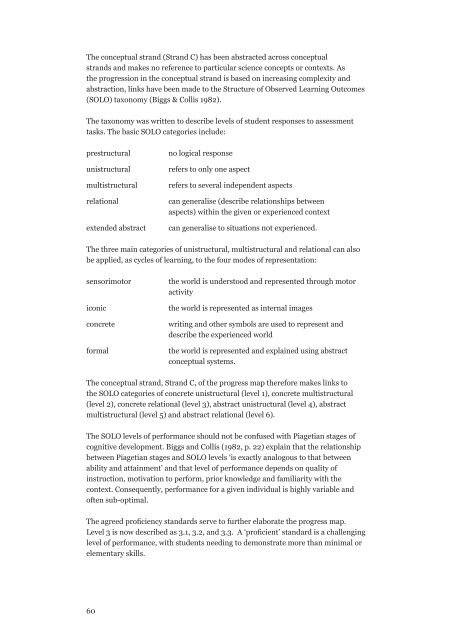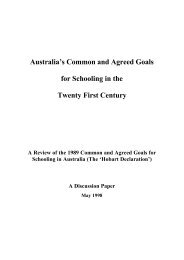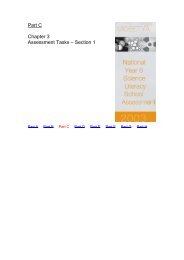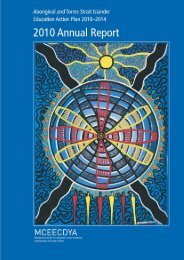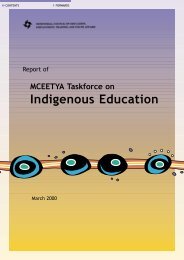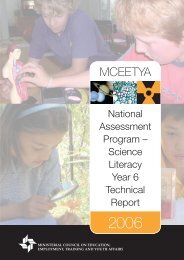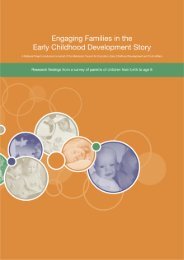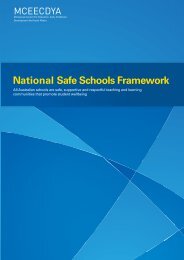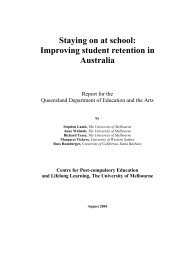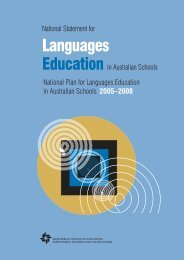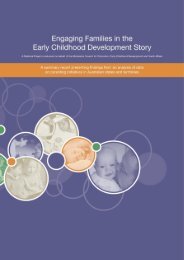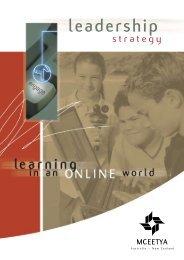The conceptual strand (Strand C) has been abstracted across conceptualstrands and makes no reference to particular science concepts or contexts. Asthe progression in the conceptual strand is based on increasing complexity andabstraction, links have been made to the Structure of Observed Learning Outcomes(SOLO) taxonomy (Biggs & Collis 1982).The taxonomy was written to describe levels of student responses to assessmenttasks. The basic SOLO categories include:prestructuralunistructuralmultistructuralrelationalextended abstractno logical responserefers to only one aspectrefers to several independent aspectscan generalise (describe relationships betweenaspects) within the given or experienced contextcan generalise to situations not experienced.The three main categories of unistructural, multistructural and relational can alsobe applied, as cycles of learning, to the four modes of representation:sensorimotoriconicconcreteformalthe world is understood and represented through motoractivitythe world is represented as internal imageswriting and other symbols are used to represent anddescribe the experienced worldthe world is represented and explained using abstractconceptual systems.The conceptual strand, Strand C, of the progress map therefore makes links tothe SOLO categories of concrete unistructural (level 1), concrete multistructural(level 2), concrete relational (level 3), abstract unistructural (level 4), abstractmultistructural (level 5) and abstract relational (level 6).The SOLO levels of performance should not be confused with Piagetian stages ofcognitive development. Biggs and Collis (1982, p. 22) explain that the relationshipbetween Piagetian stages and SOLO levels ‘is exactly analogous to that betweenability and attainment’ and that level of performance depends on quality ofinstruction, motivation to perform, prior knowledge and familiarity with thecontext. Consequently, performance for a given individual is highly variable andoften sub-optimal.The agreed proficiency standards serve to further elaborate the progress map.Level 3 is now described as 3.1, 3.2, and 3.3. A ‘proficient’ standard is a challenginglevel of performance, with students needing to demonstrate more than minimal orelementary skills.60
Table B.1 Scientific <strong>Literacy</strong> Progress Map – July 2004 version from DEST <strong>Science</strong> Education Assessment Resource(SEAR) projectLevelSOLOtaxonomy6 Abstractrelational5 AbstractmultistructuralStrand AFormulating or identifyinginvestigable questionsand hypotheses, planninginvestigations and collectingevidence.Process strand:experimental design anddata gathering.Uses scientific knowledgeto formulate questions,hypotheses and predictionsand to identify the variablesto be changed, measured andcontrolled.Trials and modifiestechniques to enhancereliability of data collection.Formulates scientificquestions or hypothesesfor testing and plansexperiments in which mostvariables are controlled.Selects equipment thatis appropriate and trialsmeasurement procedureto improve techniques andensure safety.When provided withan experimental designinvolving multipleindependent variables, canidentify the questions beinginvestigated.Strands of scientific literacyStrand BInterpreting evidenceand drawing conclusionsfrom their own or others’data, critiquing thetrustworthiness of evidenceand claims made by others,and communicating findings.Process strand: interpretingexperimental data.Selects graph type andscales that display the dataeffectively.Conclusions are consistentwith the data, explain thepatterns and relationships interms of scientific conceptsand principles, and relate tothe question, hypothesis orprediction.Critiques the trustworthinessof reported data (e.g.adequate control of variables,sample or consistency ofmeasurements, assumptionsmade in formulatingthe methodology), andconsistency between dataand claims.Conclusions explain thepatterns in the data usingscience concepts, and areconsistent with the data.Makes specific suggestionsfor improving/extending theexisting methodology (e.g.controlling an additionalvariable, changing an aspectof measurement technique).Interprets/compares datafrom two or more sources.Critiques reports ofinvestigations noting anymajor flaw in design orinconsistencies in data.Strand CUsing understandings fordescribing and explainingnatural phenomena, and forinterpreting reports aboutphenomena.Conceptual strand: appliesconceptual understanding.Explains complexinteractions, systems orrelationships using severalabstract scientific conceptsor principles and therelationships between them.SOLO: Abstract relationalExplains phenomena, orinterprets reports aboutphenomena, using severalabstract scientific concepts.SOLO: Abstractmultistructural4 AbstractunistructuralFormulates scientificquestions, identifies thevariable to be changed, thevariable to be measured andin addition identifies at leastone variable to be controlled.Uses repeated trials orreplicates.Collects and records datainvolving two or morevariables.Calculates averages fromrepeat trials or replicates,plots line graphs whereappropriate.Interprets data from linegraph or bar graph.Conclusions summarise andexplain the patterns in thescience data.Able to make generalsuggestions for improvingan investigation (e.g. makemore measurements).Explains interactions,processes or effects thathave been experiencedor reported, in terms of anon-observable property orabstract science concept.SOLO: Abstract unistructural61


